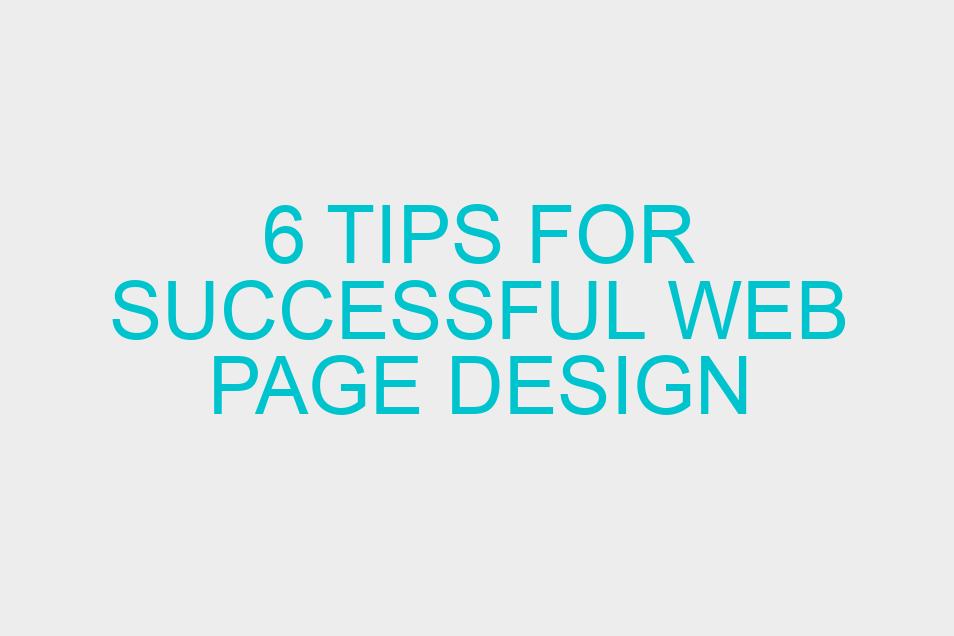6 Tips for successful web page design

Whether you’re a business owner, a blogger or an entrepreneur with an online store, simply having a website isn’t enough to guarantee success. The way in which it is designed will have a high effect on how much traffic and business it generates. There are certain design principles that need to be addressed in web page design in order for a website to become a valuable asset to you or your business.
According to Econsultancy, 47% of people expect a web page to load in two seconds or less. Furthermore, 40% of people will leave your website if it takes more than 3 seconds to load. If your website fails to perform, then you’re potentially saying goodbye to 40% of your traffic! Costly mistakes like these can easily be avoided in the development of your web page design.
As a professional web page designer with 17 years’ experience, I’ve learnt what it takes to design a successful web page. Over the years, I’ve learnt a number of design principles that today I’ll be sharing with you. Continue reading my top tips to help you enhance your web page design.
Ready to Ignite Your Website?
If you are not satisfied with your current website designer or SEO, call me, Nicole Brooke. I’m highly efficient and always available.
1. Keep things simple and clean
As a web page designer, there is nothing I find more off-putting than to come across websites that are cluttered and feel like an encyclopaedia, and I’m sure you’ll agree. These websites come off as unmanaged and unprofessional. Your web page design should be like a living room- it should be relaxing, comfortable, clean and easy to move around. The more comfortable a user feels on a website, the more likely they are to interact with it longer. If you look at your web page design and don’t get this feeling, then you need to seriously consider changing its design.
2. Calls to action
Every web page is designed for a purpose – whether it is to make sales, generate leads or to gather information. This should always be kept in mind when having your web page designed. Look at your website and see if there are obvious and clear calls to action that make it easy for users to understand what you want them to do. Does your design use contrasting colour schemes and buttons to prompt users to land on pages that you want them to go to? If you’ve answered no to these questions, your web page design will fail you and it’s time to look at a redesign.
3. Mobile responsive
Today, we not only access websites from desktop computers. In fact, over 33% of Australians use mobile phones and tablets to view websites. Therefore, you must ensure that your web page design is mobile friendly – using a responsive framework when creating the HTML template is the easiest way to achieve this. At Ignition Media, every website I create is made with Foundation’s responsive framework and thus, is mobile friendly. Responsive websites adjust automatically depending on the device they are being viewed on. Get your web page designer to build a mobile-friendly website and if they don’t have the skills to do so, be sure to give me a call and I’ll gladly provide you with a quote.
4. Quick loading
There’s nothing worse than having to wait for a website to complete loading. One of the most important, yet often overlooked components of web page design is the time in which the design will ultimately take to load. Unless a web page is optimised for page speed, it will affect your rankings, traffic and business it generates. Page speed optimisation includes optimising image sizes, combining codes into JavaScript or central CSS files and compress JavaScript, CSS and HTML to reduce load times. In order to make your web page design more effective, speak to your designer about keeping load times as low as possible.
5. Great content
You may have heard the phrase “content is king” and I, for one, believe this to be true. Content helps connect all web page design elements and helps build processes. Content is core both from marketing as well as a technical perspective. A great website always should focus on quality content. Make sure that your website content is concise, clear and relevant. Your web page design should utilise a lot of white space and organise your content properly. You can also choose to hire the services of professional copywriters, such as us at Ignition Media and we’ll make sure to put up killer content on your website.
6. SEO
Your web page should be designed with at least, basic SEO in mind. On-page SEO can really help your website become visible to search engines and this allows more traffic to your website. I make use of links, separate content under header sections and bold important words in websites that I design. I also add Meta descriptions for images and videos that are embedded onto a page. These simple techniques can really boost your organic rankings on search engines. Ensure your web page designer has a basic understanding of SEO and that the basic rules have been applied to your design.
Conclusion:
When you go about hiring a web designer for your website, make sure that certain design principles are followed. These include keeping the design simple and clear with calls to action, building a quick loading website that is also mobile responsive and insuring you have great content. SEO techniques are also advised. These basic tips can lead to a successful web page design.
Here, at Ignition Media, I have been creating successful web page designs for more than 17 years. If you find that your web designer is not following basic web design principles, then you should definitely get in contact. I’ll design and build you a great website that brings about success to your business.
